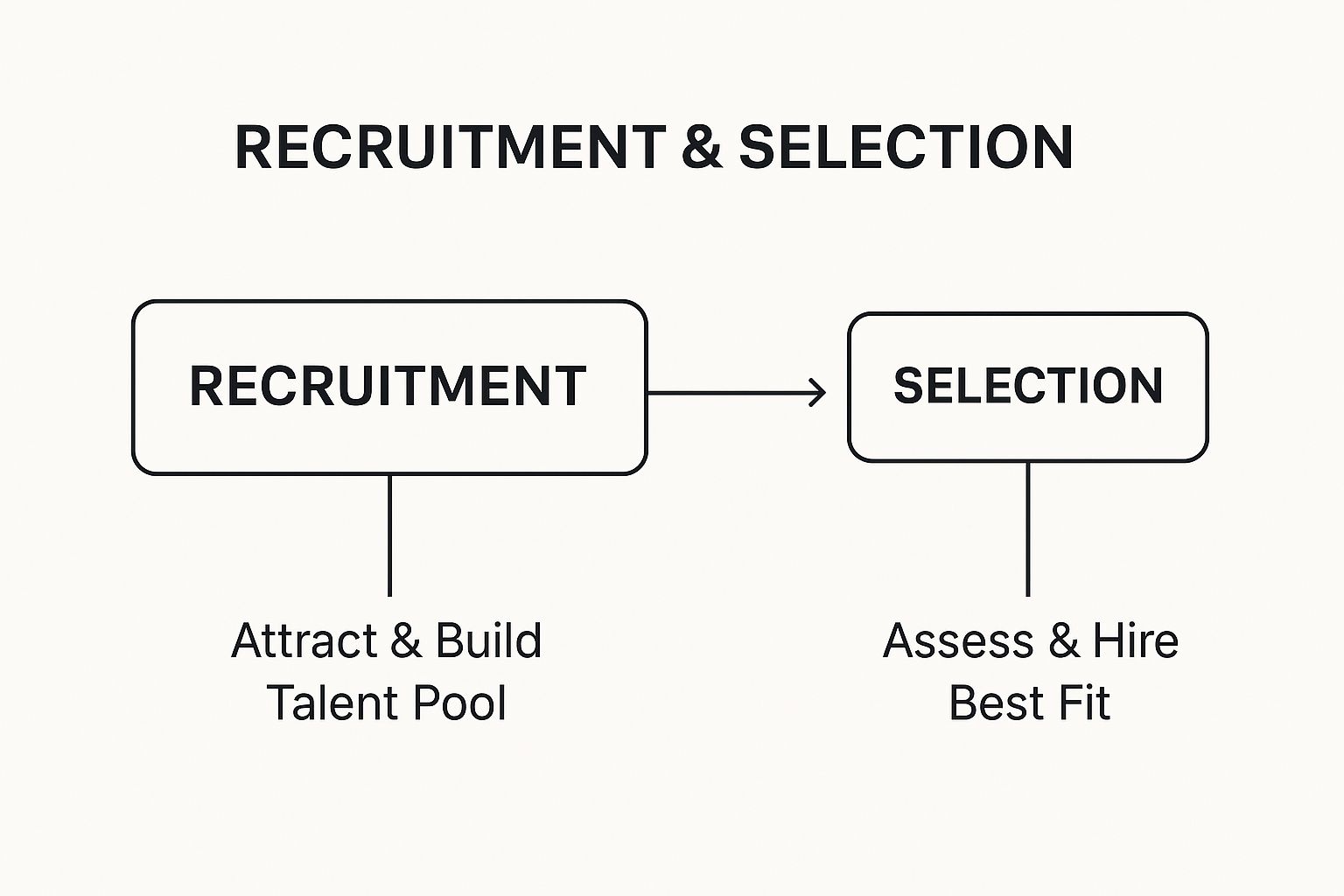Understanding the Hiring Process: Recruitment vs. Selection
This listicle clarifies the difference between recruitment and selection, two distinct yet interconnected stages in hiring. Understanding these differences is critical for CHROs in the IN region looking to optimize their hiring strategies and build high-performing teams.
We’ll cover seven key distinctions, from definitions and methodologies to legal considerations and performance metrics. This information will help you refine each stage, leading to better hiring decisions and improved outcomes. Learn how to effectively manage both recruitment and selection processes for maximum impact.
1. Definition and Purpose
Understanding the difference between recruitment and selection is fundamental to building a strong talent pipeline and hiring the right people. These two phases, while interconnected, represent distinct stages in the overall hiring process, each with its own objectives, strategies, and key performance indicators (KPIs).
Recruitment is the process of identifying, attracting, and encouraging potential candidates to apply for job positions. This process essentially builds a pool of qualified individuals interested in working for your organization.
Selection, on the other hand, follows recruitment and focuses on assessing the candidates from this pool to identify and hire the most suitable person for the specific job.
Recruitment = attracting candidates; Selection = choosing the right ones

The infographic visualizes the relationship between Recruitment and Selection, highlighting their distinct yet interconnected nature within the hiring process. It shows how recruitment feeds into selection, with the output of one stage becoming the input for the next.
The key takeaway is the clear demarcation between attracting talent (recruitment) and evaluating talent (selection).
Recruitment casts a wide net, utilizing various channels like job boards, social media, and employee referrals to reach a large number of potential candidates.
Selection, conversely, narrows down the applicants using assessment methods like interviews, skills tests, and background checks to pinpoint the best fit.
Recruitment is generally considered a positive process, focusing on encouraging applications and building interest in the organization.
Selection takes a more critical approach, eliminating unsuitable candidates until the final choice is made. Crucially, recruitment always precedes selection in the hiring process.
Here’s a clear comparison table between Recruitment and Selection–
| Aspect | Recruitment | Selection |
| Purpose | To attract a large pool of potential candidates | To choose the most suitable candidate from the applicant pool |
| Approach | Broad and encouraging | Narrow and critical |
| Focus | Creating interest and inviting applications | Screening, evaluating, and filtering candidates |
| Methods Used | Job boards, social media, referrals, career fairs | Interviews, skill tests, assessments, background checks |
| Process Nature | Positive – aims to generate interest | Selective – aims to reject the unsuitable |
| Stage in Hiring Process | Occurs first in the hiring cycle | Follows recruitment in the hiring process |
Features of Recruitment and Selection:
- Recruitment: Wide reach, attracting candidates, positive approach, precedes selection.
- Selection: Narrowed focus, assessing candidates, negative (eliminating) approach, follows recruitment.
Pros of Differentiating Recruitment and Selection:
- Resource Allocation: Understanding the differences allows CHROs to allocate budget, staff, and time appropriately to each phase.
- Improved Hiring Outcomes: Clear processes result in better hiring decisions and a stronger workforce.
- Targeted Strategies: Distinct strategies can be developed and implemented for each phase, maximizing effectiveness.
Cons of Not Differentiating:
- Blurred Lines: Organizations sometimes blur the lines between the processes, leading to confusion and inefficiency.
- Inefficiencies: Treating both as a single process can lead to poor resource allocation and ineffective hiring strategies.
- Resource Conflicts: Each phase requires different skill sets and resources, which can conflict if not managed properly.
Examples of Successful Implementation:
- Google: Separates its recruitment (handled by sourcers) from its selection process (performed by hiring committees). This ensures specialized expertise at each stage.
- Amazon: Utilizes distinct teams for recruitment marketing and candidate assessment, reflecting the different skillsets required.
Actionable Tips for CHROs in the IN region:
- Develop Separate KPIs: Track metrics like time-to-fill for recruitment and quality-of-hire for selection to measure the effectiveness of each function.
- Specialized Personnel: Assign specialized recruiters and selection specialists to each function to maximize their expertise.
- Document the Transition: Clearly document the transition point between recruitment and selection to ensure a seamless and efficient handover.
This distinction between recruitment and selection deserves a prominent place on this list because it forms the bedrock of effective hiring.
Understanding this fundamental difference allows CHROs to optimize their hiring processes, build stronger teams, and ultimately contribute to organizational success.
By implementing the tips provided and learning from successful examples, organizations in the IN region can significantly enhance their talent acquisition strategies.
2. Time and Cost Considerations
A key difference between recruitment and selection lies in their respective time horizons and cost structures.
This distinction is crucial for CHROs looking to optimize their talent acquisition strategies and budget allocation.
Recruitment is a continuous, proactive process aimed at building and maintaining a robust pipeline of potential candidates. It requires ongoing investment, regardless of immediate hiring needs, to ensure a readily available talent pool when vacancies arise.
Selection, on the other hand, is a reactive, episodic process triggered by a specific open position. It involves assessing and choosing the best candidate from the pool gathered during the recruitment phase.

Recruitment often involves long-term investments in employer branding, attending career fairs, advertising on job boards, and nurturing relationships with potential candidates. These activities contribute to building a strong employer reputation and attracting top talent.
Selection, however, focuses on the costs associated with evaluating candidates for a specific role. This includes expenses related to assessment tools, interviewer time, background checks, and onboarding. The distribution of these costs varies considerably based on industry, organization size, and the seniority of the position being filled.
Features of Time and Cost Considerations:
- Recruitment: Continuous, long-term investment; focuses on building a talent pipeline; costs include advertising, career fairs, and employer branding initiatives.
- Selection: Episodic and position-specific; focuses on evaluating and choosing candidates; costs include assessment tools, interviewer time, and background checks.
Pros of Differentiating Recruitment and Selection Costs:
- Better Resource Allocation: Separating budgets for recruitment and selection allows for more strategic allocation of resources and clearer tracking of ROI.
- Improved Workforce Planning: Understanding the time differences between recruitment and selection facilitates better workforce planning and anticipation of hiring needs.
- Enhanced ROI Calculation: Distinguishing between these stages enables a more granular calculation of ROI for different aspects of the hiring process.
Cons of Differentiating Recruitment and Selection Costs:
- Cost Attribution Challenges: Accurately attributing costs between recruitment and selection can be complex, as some activities contribute to both.
- Variable Time Requirements: Time requirements can vary significantly depending on the position level and the availability of qualified candidates.
- Budgetary Constraints: Limited budgets can force trade-offs between investing in robust recruitment efforts and conducting thorough selection processes.
Examples:
- Large corporations like IBM invest heavily in long-term recruitment strategies, such as university partnerships and graduate programs. They also leverage AI-powered tools to streamline and reduce selection costs.
- Small businesses in the IN region might allocate a larger portion of their budget to recruitment advertising on local job boards or social media platforms, while spending less on sophisticated selection tools compared to larger enterprises.
Actionable Tips for CHROs:
- Track Metrics Separately: Track “time-to-fill” (the time it takes to fill a vacant position) and “time-to-hire” (the time from initial contact with a candidate to their acceptance of an offer) separately to identify bottlenecks in your hiring process.
- Calculate Cost-Per-Hire with Breakdowns: Calculate cost-per-hire with detailed breakdowns for recruitment and selection expenses to optimize spending and identify areas for improvement.
- Invest in Recruitment Technology: For positions with high turnover, invest in recruitment technology, like applicant tracking systems (ATS), to automate tasks and improve efficiency.
- Allocate Resources Strategically: Allocate more selection resources, such as specialized assessments and multiple interview rounds, for senior or critical positions.
This understanding of time and cost considerations in recruitment and selection is popularized by organizations like the Society for Human Resource Management (SHRM) with their standardized cost-per-hire metrics, and Bersin by Deloitte’s research on talent acquisition.
By carefully analyzing these factors, CHROs can develop more effective and cost-efficient talent acquisition strategies.
3. Methodologies and Techniques
A core difference between recruitment and selection lies in the methodologies and techniques employed.
This distinction is crucial for CHROs aiming to optimize their hiring processes.
Recruitment methodologies cast a wide net, focusing on marketing, outreach, and attraction strategies to build a robust candidate pool. Think of it as building awareness and generating interest in your company as an employer of choice.
Selection, on the other hand, is about assessment, evaluation, and predicting future job performance to pinpoint the best fit candidates from that pool. It’s about analyzing skills, experience, and cultural fit.
This difference is why understanding the specific techniques used in each phase is critical for effective hiring.
Recruitment often utilizes techniques like job boards (Naukri.com, Indeed), social media campaigns (LinkedIn, Twitter), employee referral programs, and employer branding initiatives. These methods are marketing-oriented, designed to reach a broad audience and create a positive impression of your company.
Selection, conversely, employs techniques like interviews (structured, behavioral, panel), assessments (technical skills tests, personality questionnaires, aptitude tests), background checks, and reference verification. These assessment-oriented techniques aim to evaluate candidates’ qualifications and suitability for the specific role.
This distinction deserves its place in understanding the difference between recruitment and selection because it highlights the specialized nature of each function.
Different methodologies allow for expertise in distinct areas, enabling tailored approaches for diverse job categories and facilitating continuous improvement in separate processes. For example, a tech company recruiting for software engineers might prioritize technical assessments and coding challenges in the selection phase, while a marketing agency might emphasize portfolio reviews and creative thinking exercises.
Examples of successful implementation: Unilever has effectively used gamification in its recruitment process to attract a wider pool of candidates, making the initial application process more engaging. However, their selection process relies on structured interviews to maintain objectivity and consistency. Similarly, McKinsey uses case studies as a key selection tool to evaluate problem-solving skills, while relying on targeted campus recruitment methods for attracting high-potential graduates.
Pros:
- Specialized expertise in each area.
- Tailored approaches for different roles.
- Continuous improvement in distinct processes.
Cons:
- Methodologies must align to maintain consistency throughout the hiring process.
- Mismatched techniques can create disconnect between candidate expectations set during recruitment versus selection experiences.
- Requires different expertise and sometimes different teams.
Tips for CHROs in the IN region:
- Align recruitment messaging with selection criteria to ensure consistency. If your selection process emphasizes teamwork, highlight collaboration opportunities in your recruitment materials.
- Use recruitment techniques that naturally pre-screen for selection criteria. For example, requiring a portfolio for creative roles can help filter candidates early in the process.
- Regularly evaluate the effectiveness of both recruitment and selection methodologies. Track key metrics like time-to-hire, cost-per-hire, and quality of hire to identify areas for improvement.
- Consider the candidate experience across both processes. A positive and consistent experience throughout strengthens your employer brand and attracts top talent.
The work of industrial-organizational psychologists like Adam Grant and John Sullivan, as well as LinkedIn’s talent solutions research, has popularized the importance of understanding these distinct methodologies.
Learn more about Methodologies and Techniques for insights on streamlining your recruitment steps. By understanding and strategically implementing these different methodologies and techniques, CHROs can significantly improve their hiring outcomes and build a strong, talented workforce.
4. Legal and Compliance Considerations
A critical difference between recruitment and selection lies in their respective legal and compliance challenges.
Understanding these nuances is crucial for CHROs operating in India, where labor laws and regulations are complex and constantly evolving. While both processes must adhere to equal employment opportunity and anti-discrimination laws like The Equal Remuneration Act, 1976, and The Scheduled Castes and Scheduled Tribes (Prevention of Atrocities) Act, 1989, they encounter these requirements in distinct contexts. This distinction warrants separate strategies and documentation for each process, impacting everything from how you source candidates to how you make final hiring decisions.
This is why legal and compliance considerations deserve a prominent place in any discussion about the difference between recruitment and selection.
Recruitment focuses on attracting a diverse pool of qualified applicants. Compliance in this stage centers on ensuring inclusive sourcing and non-discriminatory advertising.
This means your outreach efforts must reach a broad spectrum of potential candidates, regardless of protected characteristics like caste, religion, gender, or disability. Your job advertisements must use inclusive language and be distributed on platforms accessible to diverse groups.
For instance, relying solely on online platforms might exclude individuals with limited internet access, creating an unintentional bias.
Selection, on the other hand, is about evaluating candidates and making hiring decisions. Here, compliance emphasizes validating candidate assessment methods and their consistent application. The selection tools you use, whether they are aptitude tests, interviews, or background checks, must be relevant to the job and free from bias.
They must also be applied consistently to all candidates to ensure a fair evaluation process. Moreover, Indian CHROs need to be particularly mindful of regulations surrounding background checks and medical examinations, ensuring they are conducted ethically and legally.
Features and Benefits of Separate Compliance Strategies:
- Recruitment: Focus on accessibility and representation in sourcing and advertising. This ensures a wider talent pool and reduces the risk of discrimination claims related to outreach.
- Selection: Emphasis on validation and consistent application of assessment methods. This minimizes legal risks associated with adverse impact and promotes merit-based hiring decisions.
Pros:
- Targeted compliance strategies address the specific risks inherent in each process.
- Distinct documentation requirements simplify record-keeping and facilitate regulatory audits.
- Clear delineation of responsibilities improves accountability and streamlines compliance efforts.
Cons:
- Maintaining alignment between recruitment and selection compliance standards can be challenging.
- Varying legal requirements across states in India, and internationally for multinational companies, add complexity.
- Compliance costs can be substantial for both processes, requiring investment in training, technology, and legal counsel.
Examples:
- A global tech company operating in India might face legal challenges if their online recruitment portal isn’t accessible to candidates in rural areas with limited internet connectivity (Recruitment).
- A retail company could be scrutinized if their personality tests disproportionately screen out candidates from certain socio-economic backgrounds during the selection process (Selection). This reflects the similar situation faced by Target Corporation in the US when they restructured their background check policy.
Actionable Tips for CHROs in India:
- Maintain separate, meticulous documentation for recruitment outreach and selection decisions.
- Conduct adverse impact analyses on selection procedures to identify and mitigate potential biases. Pay special attention to how these procedures affect Scheduled Castes and Scheduled Tribes.
- Ensure job advertisements comply with non-discrimination requirements as laid out in Indian law. Use inclusive language and avoid any language that could be construed as discriminatory.
- Train recruiters and hiring managers on the specific legal and compliance aspects of both recruitment and selection processes within the Indian context. This training should cover relevant laws like The Persons with Disabilities (Equal Opportunities, Protection of Rights and Full Participation) Act, 1995.
Popularized By:
While the EEOC and SHRM provide valuable guidance, Indian CHROs should also refer to resources provided by the Ministry of Labour and Employment and consult with legal experts specializing in Indian employment law.
This will ensure compliance with local regulations and best practices. The expertise of industrial-organizational psychologists familiar with the Indian legal landscape can be particularly valuable.
5. Stakeholder Involvement: A Key Difference Between Recruitment and Selection
A critical distinction between recruitment and selection lies in the stakeholder involvement.
Understanding the different players and their roles in each process is crucial for efficient and effective hiring, especially for CHROs overseeing the entire talent acquisition lifecycle.
This aspect significantly impacts how you structure your hiring process and allocate resources.
Recruitment and selection are distinct yet interconnected stages, each involving different stakeholders with varying responsibilities.
Recruitment focuses on attracting a large and diverse pool of potential candidates. This stage primarily involves HR professionals, recruiters, and marketing teams, often leveraging external agencies to expand reach. Their focus is on quantity and diversity, ensuring a wide net is cast to capture talent.
Selection, on the other hand, is the process of evaluating these candidates against specific job requirements and team fit to identify the best match. This stage involves hiring managers, departmental teams, and sometimes senior leadership or even clients. Their focus shifts to quality and fit assessment, ensuring the selected candidate possesses the required skills and aligns with the company culture.
The difference in focus, from quantity in recruitment to quality in selection, necessitates distinct stakeholder groups with specialized expertise.
For instance, recruitment stakeholders might leverage social media campaigns and job boards to reach a wider audience, while selection stakeholders will conduct technical interviews, assess cultural add and culture fitment, and perhaps even involve candidates in practical exercises relevant to the role.
Features of Stakeholder Involvement:
- Recruitment: Primarily involves HR, recruiters, and marketing professionals. Focuses on quantity and diversity of candidates.
- Selection: Involves hiring managers, potential colleagues, and sometimes customers or clients. Focuses on quality and fit assessment.
Pros of Distinct Stakeholder Involvement:
- Comprehensive Evaluation: Different perspectives ensure a well-rounded evaluation of candidates, considering both skillset and cultural fit.
- Specialized Roles: Allows for expertise in different aspects of the hiring process, optimizing both outreach and evaluation.
- Checks and Balances: The separation creates checks and balances, minimizing bias and ensuring a fair process.
Cons of Managing Multiple Stakeholders:
- Coordination Challenges: Managing communication and expectations across different stakeholder groups can be complex.
- Conflicting Priorities: Potential for conflicting priorities and assessment criteria between different stakeholders.
- Time Management: Involving multiple stakeholders in the selection process can lead to scheduling difficulties and extended timelines.
Examples of Successful Implementation:
- Zappos famously involves customer service representatives in the selection process, giving them a voice in choosing future colleagues, but not in the initial recruitment phase. This helps ensure new hires align with their customer-centric culture.
- Microsoft’s specialized technical recruitment team focuses on sourcing and attracting technical talent, distinct from the technical interview panels comprised of engineers and team leads who conduct the selection process.
Actionable Tips for CHROs:
- Clearly Defined Roles: Create clear role definitions and responsibilities for stakeholders in both recruitment and selection processes.
- Alignment Meetings: Hold joint meetings between recruitment and selection stakeholders to align expectations and assessment criteria.
- Targeted Training: Train hiring managers on their specific selection responsibilities, differentiating them from recruitment activities.
- Feedback Mechanisms: Develop feedback loops between stakeholder groups to continuously improve the hiring process.
Learn more about Stakeholder Involvement
Popularized by models such as Google’s hiring committee and Netflix’s “keeper test” approach, a clearly defined stakeholder involvement strategy is crucial for successful hiring. These approaches emphasize the importance of diverse perspectives in the selection process, further highlighting the critical role of stakeholder involvement.
This item deserves its place on this list because it directly impacts the efficiency, effectiveness, and fairness of the entire hiring process, a key concern for any CHRO in the IN region aiming to build high-performing teams.
Understanding the nuanced difference between recruitment and selection stakeholders allows for better resource allocation, streamlined processes, and ultimately, better hiring outcomes.
6. Performance Metrics and Success Indicators
A key difference between recruitment and selection lies in how their success is measured.
Understanding these distinct performance metrics and success indicators is crucial for optimizing both processes and achieving overall hiring goals. This distinction allows CHROs to gain granular insights into the effectiveness of their talent acquisition strategy and make data-driven decisions.
Recruitment and selection, while interconnected, have different objectives.
Recruitment focuses on attracting a large, diverse, and qualified pool of candidates.
Selection, on the other hand, concentrates on identifying the best fit from that pool. Consequently, their performance metrics reflect these separate goals.
Recruitment metrics typically revolve around volume, efficiency, and diversity. These include:
- Source Effectiveness: Which recruitment channels (e.g., LinkedIn, job boards, employee referrals) yield the highest quality and quantity of applicants?
- Time-to-Fill: How long does it take to fill open positions? A shorter time-to-fill often indicates a more efficient recruitment process.
- Applicant Pool Diversity: Does the applicant pool reflect the desired diversity targets in terms of gender, ethnicity, background, etc.? This metric is increasingly important for organizations committed to building inclusive workforces.
Selection metrics, conversely, emphasize the quality of hire, prediction accuracy, and decision efficiency. Key selection metrics include:
- Quality of Hire: This often involves assessing new hires’ performance, productivity, and cultural fit after a certain period. It’s a crucial indicator of the effectiveness of the selection process.
- Selection Ratio: This is the ratio of the number of job offers made to the total number of applicants. A lower selection ratio might indicate a more rigorous and selective process.
- Assessment Validity: This measures how effectively the selection tools (e.g., interviews, tests, assessments) predict future job performance.
This difference in measurement is essential. Recruitment success is measured by the health of the candidate pipeline, while selection success is measured by new hire performance and retention.
Organizations like Salesforce and Deloitte exemplify this by tracking recruitment and selection metrics separately, allowing for a more nuanced understanding of their talent acquisition effectiveness.
Salesforce, for instance, tracks recruitment metrics quarterly but analyzes selection metrics for each specific position, tailoring its analysis to the unique requirements of each role. Deloitte separates its sourcing effectiveness metrics from its assessment validation statistics, recognizing that these are distinct aspects of the overall hiring process.
Pros of Using Distinct Metrics:
- Targeted Improvements: Specific metrics allow for targeted improvements in each process. For instance, if time-to-fill is lagging, recruiters can focus on streamlining their processes.
- Clear Accountability: Separate KPIs (Key Performance Indicators) clarify responsibilities and accountability for both recruitment and selection teams.
- Independent Optimization: This allows for optimization of each process independently without negatively impacting the other.
Cons of Using Distinct Metrics:
- Alignment with Overall Goals: Metrics must ultimately align with the overall hiring goals of the organization. Overemphasis on one set of metrics can be detrimental.
- Interdependency of Processes: Over-optimizing one process (e.g., focusing solely on a high volume of applicants in recruitment) can negatively impact the other (e.g., overwhelming the selection team with too many unqualified candidates).
- Complex Tracking: Requires more complex tracking and analysis systems to manage different sets of data.
Tips for CHROs in the IN region:
- Develop a Balanced Scorecard: Implement a balanced scorecard with distinct recruitment and selection KPIs. This provides a holistic view of the entire talent acquisition process.
- Regular Review: Regularly review and analyze how improvements in one area affect the other. For instance, has a faster time-to-fill negatively impacted the quality of hire?
- Clear Ownership: Establish clear ownership for different metrics within the recruitment and selection teams.
- Leverage Technology: Use technology, including talent acquisition platforms like Greenhouse and Lever, to automate measurement and gain deeper insights into both pipeline and assessment analytics.
This focus on distinct metrics has been popularized by HR analytics pioneers like Josh Bersin and John Sullivan, as well as by organizations like SHRM (Society for Human Resource Management), which provides guidance on metrics standards.
By understanding the difference between recruitment and selection metrics, CHROs in the IN region can build a more robust and effective talent acquisition strategy, leading to a stronger and more competitive organization.
7. Technology and Tools: A Key Differentiator Between Recruitment and Selection
A critical difference between recruitment and selection lies in the technology and tools deployed for each process.
This distinction is crucial for CHROs looking to optimize their hiring strategies and build strong teams.
Understanding the nuances of recruitment vs. selection technologies empowers you to make informed decisions, streamline your workflows, and ultimately, hire the best talent.
Recruitment technology primarily focuses on attracting and engaging potential candidates, building a robust candidate pipeline, and managing candidate relationships. Think of it as the process of casting a wide net. These tools help HR professionals source candidates from various channels, automate communication, and track applicants throughout the initial stages. Common recruitment sorftware and tools include:
- Applicant Tracking Systems (ATS): Manage applications, track candidate progress, and automate communication.
- Job Boards (e.g., Naukri.com in IN): Advertise open positions and reach a large pool of candidates.
- CRM Platforms: Nurture relationships with potential candidates and build talent pools for future opportunities.
- Social Recruiting Tools (e.g., LinkedIn Recruiter): Identify and engage passive candidates on social media platforms.
Selection technology, on the other hand, is geared towards evaluating and assessing the shortlisted candidates to identify the best fit for the role. This stage involves narrowing down the pool to select the ideal candidate. These tools enable in-depth assessments of skills, experience, and cultural fit. Examples of selection tools include:
- Assessment Platforms: Evaluate cognitive abilities, personality traits, and job-specific skills.
- Video Interviewing Software: Conduct virtual interviews and assess communication skills and cultural fit.
- Skills Testing Solutions: Measure candidates’ proficiency in specific technical skills and software applications.
- Background Check Systems: Verify candidate credentials and ensure compliance with regulations.
Pros of Using Specialized Technology:
- Optimized Hiring: Specialized tools optimize each phase, leading to a more efficient and effective hiring process.
- Bias Reduction: Technology can help mitigate bias in both recruitment and selection, albeit through different mechanisms (e.g., blind resume screening in recruitment, standardized assessments in selection).
- Workflow Automation: Automating distinct workflows frees up HR professionals to focus on strategic initiatives.
Cons to Consider:
- Integration Challenges: Ensuring seamless data flow between recruitment and selection systems can be a challenge.
- Technology Silos: Different systems can create data silos and inconsistencies, hindering a holistic view of the candidate.
- Learning Curves: Teams specializing in recruitment or selection may face different learning curves when adopting new technologies.
Examples of Technology Providers:
HireVue, for example, offers both recruitment (CRM) and selection (video interviewing) tools, but as separate modules. LinkedIn is primarily a recruitment tool, while Pymetrics focuses on selection assessments. These distinctions highlight the specialization within the HR tech landscape.
Actionable Tips for CHROs in the IN Region:
- Seamless Data Flow: Prioritize seamless data flow between recruitment and selection systems to ensure a unified candidate experience and efficient data management.
- Complementary Functionality: Select tools that complement each other rather than duplicate functionality, avoiding redundancy and unnecessary costs.
- Candidate Experience: Consider the candidate experience across the entire technology stack, ensuring a positive and engaging journey from application to onboarding.
- ROI Evaluation: Evaluate the return on investment (ROI) separately for recruitment and selection technologies to understand their individual impact on hiring outcomes.
Learn more about Technology and Tools This resource provides further insights into streamlining your online recruitment processes.
This focus on distinct technologies for recruitment and selection justifies its place in this list, highlighting a crucial aspect of modern hiring practices. By understanding and leveraging the right technologies, CHROs can significantly improve their hiring outcomes and build high-performing teams.
Influencers like Josh Bersin and Jason Averbook, as well as major vendors like Workday, Oracle, and SAP, and AI pioneers like Textio (recruitment) and Koru (selection) continually drive innovation in this space, providing ever-evolving solutions to optimize the entire hiring lifecycle.
7-Key Factors Comparing Recruitment vs Selection
| Aspect | Recruitment | Selection |
|---|---|---|
| Implementation Complexity | Generally moderate; requires broad outreach and ongoing talent pool management | Often higher complexity; involves detailed assessments and decision-making processes |
| Resource Requirements | Resources focused on marketing, advertising, employer branding, and candidate engagement | Resources allocated to interviews, assessments, background checks, and evaluator time |
| Expected Outcomes | Build a diverse and large candidate pool for potential hires | Identify and hire the best-fit candidates for specific job roles |
| Ideal Use Cases | Continuous talent pipeline development, high-turnover roles | Filling specific vacancies, senior or specialized positions requiring thorough evaluation |
| Key Advantages | Wide reach and positive candidate engagement; strengthens employer brand | Focused selection accuracy; improves hire quality and workforce fit |
| Tips & Insights | Develop separate KPIs; assign specialized personnel; track time-to-fill and cost-per-hire separately | Align assessment methods with recruitment messaging; conduct adverse impact analyses; automate workflows |
Mastering Recruitment and Selection with Taggd
Understanding the difference between recruitment and selection is paramount for building a high-performing team.
This article has explored seven key distinctions, from defining their respective purposes and associated costs to examining the methodologies, legal considerations, stakeholder involvement, performance metrics, and technological tools involved in each.
By recognizing these differences, CHROs and other HR leaders can develop more strategic and efficient hiring processes. Mastering these concepts translates directly to better hiring outcomes, reduced time-to-fill, improved quality of hire, and ultimately, a stronger, more competitive organization.
This knowledge empowers you to not just fill positions, but to strategically acquire top talent that drives your business goals forward in the competitive IN market.
For businesses seeking to refine their approach to talent acquisition and truly grasp the difference between recruitment and selection, optimizing each stage is crucial. Taggd provides expert Recruitment Process Outsourcing (RPO) services designed to streamline your hiring process, from targeted recruitment campaigns to data-driven selection strategies.
Visit Taggd today to discover how we can help you build a winning talent acquisition strategy and achieve exceptional hiring outcomes.







